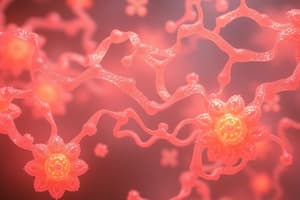Podcast
Questions and Answers
What is the main purpose of gel electrophoresis?
What is the main purpose of gel electrophoresis?
- To extract red seaweed for agarose gel
- To separate and analyze nucleic acids and proteins differing in size, charge, or conformation (correct)
- To analyze the charge of molecules
- To create a mesh-like structure for DNA migration
What is the role of agarose in gel electrophoresis?
What is the role of agarose in gel electrophoresis?
- To provide electrical current for migration of molecules
- To extract nucleic acids from red seaweed
- To form a network of bundles for DNA migration
- To create porous gel for molecule travel during electrophoresis (correct)
How does the concentration of agarose affect the pore size?
How does the concentration of agarose affect the pore size?
- Lower concentration results in denser matrix and smaller pores
- Higher concentration results in denser matrix and smaller pores (correct)
- Lower concentration results in larger pores
- Higher concentration results in larger pores
What determines the migration speed of molecules in an agarose gel?
What determines the migration speed of molecules in an agarose gel?
Why are most agarose gels made between 0.7% and 2% agarose?
Why are most agarose gels made between 0.7% and 2% agarose?
What is the toxicity level of agarose in gel electrophoresis?
What is the toxicity level of agarose in gel electrophoresis?
Why is gel used as a sieving medium during electrophoresis?
Why is gel used as a sieving medium during electrophoresis?
Flashcards are hidden until you start studying
Study Notes
Gel Electrophoresis
- The main purpose of gel electrophoresis is to separate and analyze mixtures of DNA, RNA, and proteins based on their size and charge.
Role of Agarose
- Agarose is used as a sieving medium in gel electrophoresis to separate molecules based on their size.
- Agarose is a polysaccharide extracted from the cell walls of red algae, and it forms a matrix of fibers that act as a molecular sieve.
Agarose Concentration and Pore Size
- The concentration of agarose affects the pore size of the gel, with higher concentrations resulting in smaller pores and lower concentrations resulting in larger pores.
Migration Speed of Molecules
- The migration speed of molecules in an agarose gel is determined by their size, with smaller molecules migrating faster than larger molecules.
Optimal Agarose Concentration
- Most agarose gels are made between 0.7% and 2% agarose because this concentration range provides an optimal pore size for separating most DNA and RNA molecules.
Agarose Toxicity
- Agarose is non-toxic and non-inflammatory, making it an ideal component for gel electrophoresis.
Gel as a Sieving Medium
- Gel is used as a sieving medium during electrophoresis because it provides a three-dimensional matrix that retards the migration of molecules based on their size, allowing for separation and analysis.
Studying That Suits You
Use AI to generate personalized quizzes and flashcards to suit your learning preferences.




